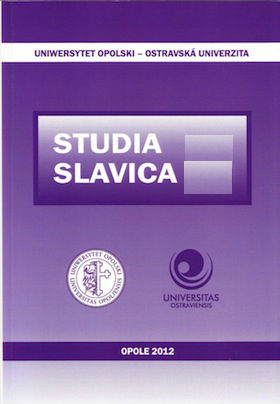Ontologia powieści Górnołużyczan (wybrane zagadnienia ze szczególnym uwzględnieniem utworów niemieckojęzycznych)
The Ontology of the Upper Sorbs’ Novel (Selected Issues with a Particular Emphasis on the Novel
in German)
Author(s): Tomasz DerlatkaSubject(s): Literary Texts
Published by: Uniwersytet Opolski
Keywords: Upper Sorbian literature; Upper Sorbs’ novel; Upper Sorbs’ novel in German; the equivalence of language variants in Upper Sorbs’ novel; the ontology of the Upper Sorbs’ novel in German
Summary/Abstract: is settled by two aspects. Firstly, some novels, even if they had an Upper Sorbian variant, sometimes a primary one, have been translated into foreign languages from a (secondary) German-language variant (the case of the novel by J. Brìzan Robert a Sabina). This indeed sometimes resulted in evident problems, not just technical ones, but above all related to an inadequate presentation of the Upper Sorbian element. Secondly, in terms of the circulation of the novel in the German language, the Upper Sorbian editions are simply overwhelming. The mini-novel, Christa by J. Brìzan, had three Upper Sorbian editions and as many as thirty in German, whereas the trilogy by this author about Feliks Hanuš reached German-speaking public in over a million copies. The most interesting phenomenon in the theory of literature concerning the Upper Sorbian (German-language) novel are the relationships between the German and Upper Sorbian variants of the novel. Their first aspect is the primacy of a particular variant. The starting version for some of the novels was the Upper Sorbian variant, for others – the German one, which resulted in the fact that, for example the first two parts of J. Brìzan’s trilogy, prepared by him in German, were translated into Upper Sorbian by another writer (sic). Some of the novels that have two language variants are homogeneous in every respect: as far as the structure, title, and the name and surname of the author are concerned. It should be emphasized, however, that this phenomenon is less significant, because we are talking of four such cases only. A much more common, and thus more important phenomenon is the dissimilarity of the language variants. Køesæan Krawc is the author of the novel in Upper Sorbian entitled Woèakñmy nalìæo (1989), and a man named Christian Schneider – the author of the novel in German Meine Braut, deine Braut?, published in 1990. In fact it is the same author and the same novel. The Upper Sorbian and German variants of the second part of J. Brìzan’s dilogy about Krabat (1994) differs significantly within its structure. The Upper Sorbian edition has thirty-seven chapters, while the German variant only fifteen. On the other hand, the German version has a kind of a prologue (as a Vorgeschichte function), which is not found in the Upper Sorbian version. The existence of the Upper Sorbs’ German-language novel is a major challenge for Sorbian literary studies. On the one hand, sometime significant difference of a German-language variant of the novel puts into question its affinity to the area of the Upper Sorbian literature. On the other hand, the history and poetics of the Upper Sorbs’ German-language novel truly reflect the paradigmatic changes that occurred after 1945 in their culture, literature, and finally, their identity.
Journal: Studia Slavica
- Issue Year: 18/2014
- Issue No: 2
- Page Range: 59-76
- Page Count: 17

